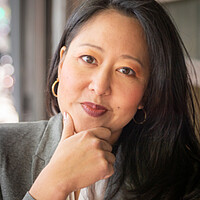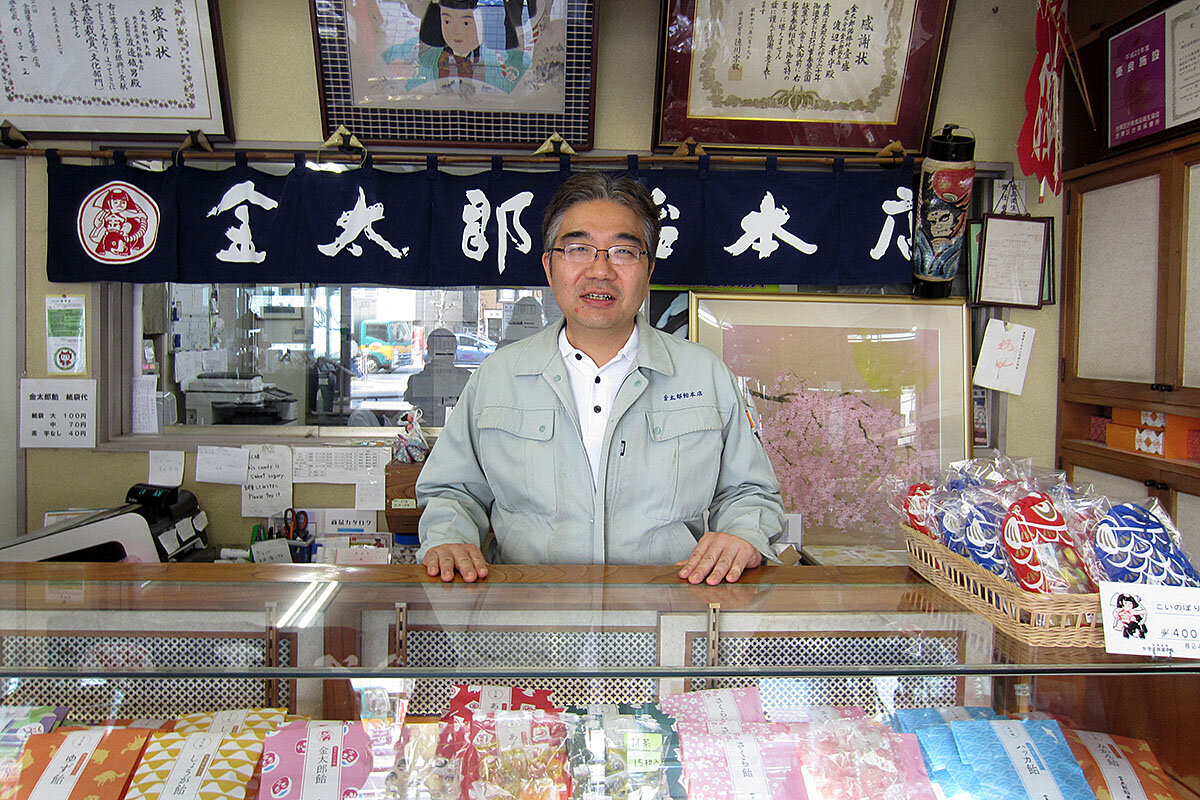Nostalgia and hope as Japan’s emperor hands over throne
Loading...
| Tokyo
The staff of candy company Kintaro-Ame was fixated on the television April 1, awaiting news of the name of Japan’s new imperial era.
Finally, at midday, a serious, suited official appeared on the screen, bearing a white placard. “Reiwa” (pronounced Ray-wah), it proclaimed in bold black calligraphy. The Kintaro-Ame workers leaped into action. Within a half-hour, they were brewing molten rivers of colored sugar and coaxing them into cylindrical designs.
In another two hours, the first “Reiwa”-branded candies were bagged in shiny plastic and placed on shelves, each piece displaying the tiny characters for “beautiful harmony,” as the Foreign Ministry translates the new era’s name.
Why We Wrote This
Everything from newspapers to cans of “the air of the outgoing era” have become commemorative souvenirs ahead of the imperial handover. But the spending speaks to something deeper than a rare marketing opportunity.
“First came an order for 10,000 pieces,” says Kintaro-Ame president Akio Watanabe, a member of the sixth generation to run the family confectionery. Then came the local media, followed by corporate customers. “Now we’re barely keeping up with demand. We’ve sold 50 times what we expected.”
On the eve of Emperor Akihito’s abdication and his son Naruhito’s ascension to the throne, companies have stumbled upon imperial naming gold. Unlike the last transition in 1989, when the long illness and death of wartime emperor Hirohito triggered national mourning, the departing Emperor Akihito is healthy, and the Japanese are looking ahead to a new, more hopeful era.
A vast majority of Japanese approve of Emperor Akihito’s request to step down, the first time in roughly 200 years that an emperor in the world’s oldest continuous monarchy has done so. Emperor Akihito and his wife are seen as much more accessible and human than his father, Emperor Hirohito, whose demigod status and political power came to an end with his country’s defeat in World War II. During Emperor Akihito’s reign, known as Heisei, or “achieving peace,” Japan has worked to distance itself from its brutal wartime past and the pain of the early post-war era. But it has also watched its economic might slip from the seemingly boundless growth of the 1980s to stubborn stagnation and a national soul-searching about its future. Naruhito’s accession provides a welcome diversion.
“People are using the era change as an excuse to be festive,” says Chuo University sociologist Masahiro Yamada. “The Japanese love to have fun … love a reason to celebrate.”
The circumstances are just right for a spending spree. Imperial transition ceremonies will fall inside a 10-day holiday, the longest-ever Golden Week. Branding expert Ryuji Ando calls it “good national policy. It’s an opportunity to boost our economy in Japan. The money will flow.”
Also in the back of Japanese minds is a pending consumption tax hike of 2%, scheduled for October. In other words, buy now. Brands including Coca-Cola, Kit Kat, and instant noodle manufacturer Nissin Food Products have launched Reiwa-themed goods. Website domain registries are reporting a jump in Reiwa-related registrations.
Heisei: A time of challenges
For many, the three-decade Heisei era under Emperor Akihito will be remembered as a time of struggle, a fall made more poignant because the era began at the country’s economic peak. After the devastation of WWII, Japan’s decades of economic recovery and growth were seen as almost a miracle. Indeed, the start of the Heisei was so flush that a businessman might jet to Seoul just to have dinner and land back in Tokyo for breakfast, says Stephen Nagy, professor of international relations at International Christian University in Tokyo.
Yet that “bubble economy” soon burst, ushering in a recession. The country lost its economic footing and eventually slipped from the world’s second-largest economy to third, behind the United States and China. The population began a slow and ominous decline, prompting further economic anxieties as the workforce shrank.
The Heisei era also saw a series of natural disasters now cemented in the national consciousness, including the 1995 Kobe earthquake and the Tokyo subway sarin gas attack two months later – not to mention the magnitude 9 quake and tsunami in 2011 that killed around 16,000 people, with thousands still missing. The government is still cleaning up the resulting Fukushima nuclear disaster, the world’s worst nuclear accident since Chernobyl.
The solemnity that simmers beneath the national consciousness, in fact, has led to a groundswell of resistance to Tokyo’s hosting of the 2020 Olympics, which many analysts say will leave a debt-ridden government even more cash-strapped.
It’s a great time for new beginnings.
Reiwa: Beautiful harmony
“I can feel society’s celebratory mood,” says sales manager Hidetoshi Mio at Bunmeido, a cake company that dates back to 1900. Bunmeido did not sell a Heisei-named good during the 1989 imperial transition, but this time, Mr. Mio says, the “emperor is still well.”
Indeed, Emperor Akihito wielded great moral authority, using his symbolic role to subtly emphasize peace and remorse for Japan’s midcentury aggressions. He is more visible than his long line of predecessors, though the royal family’s remove from the public is still far greater than that of their European peers. And there’s a sense of national gratitude for the emperor’s handling of the post-bubble stagnation, says Jeff Kingston, a professor at Temple University in Tokyo.
Asahi, the nation’s largest beer company, is feting Emperor Akihito’s retirement with a Reiwa beer that has already clocked orders of 570,000 cases, twice initial projections, according to a company spokesperson. Ozeki Sake is selling a Reiwa sake as a nod to the future as well as the past: Reiwa labels are being placed on a product first introduced around the 1964 Tokyo Olympics, an emblem of Japan’s post-war reconstruction and national reinvention.
Most Japanese are expected to watch the televised transition ceremonies, and after the hubbub dies down, the imperial name will be woven into the fabric of everyday life. In the Japanese calendar, used alongside the Western date on formal documents, coins, and government forms, Year 1 of the Reiwa era will begin May 1.
At the department store Tokyu Hands, shopper Yoko Inoue is browsing a Reiwa-themed display. “I was looking for a gift for a friend,” Ms. Inoue says. “He’s moving to America, and I thought Reiwa would be good for someone starting a new life.”
A family story mirrors Japan’s journey
Back at Kintaro-Ame, a week before the imperial transition, workers in hairnets begin hand-rolling melted sugar in an upstairs production room. In the downstairs office, Mr. Watanabe reminisces as he readies for the busy holiday period, pencil tucked into a slim pocket on his left shirtsleeve.
In its heyday, Kintaro-Ame boasted more than 30 candy stores. “Now we’re down to three stores,” Mr. Watanabe says of the family business that his ancestors began in the 1870s. “Candy consumption has been falling for years.”
Mr. Watanabe’s journey down his family’s memory lane reflects the ebb and flow of a nation: the Great Kanto earthquake of 1923, which spared the main store in Tokyo; the U.S. air raids during WWII, which forced the family to evacuate Tokyo for their hometown in Saitama prefecture; the ensuing food shortages that lasted several years, including a time the family couldn’t buy sugar to make candy; the declining sales of chitose ame, “thousand-year candy” given to children reaching the milestones of ages 3, 5, and 7, as Japan’s birth rate slipped to its lowest levels in history.
The imperial transition is a welcome break from everyday business. Mr. Watanabe had devised Reiwa-branded candy “just for fun,” he says, but now the company’s future is looking a little bit more colorful.
An imperial transition is “once in a lifetime,” he says.







